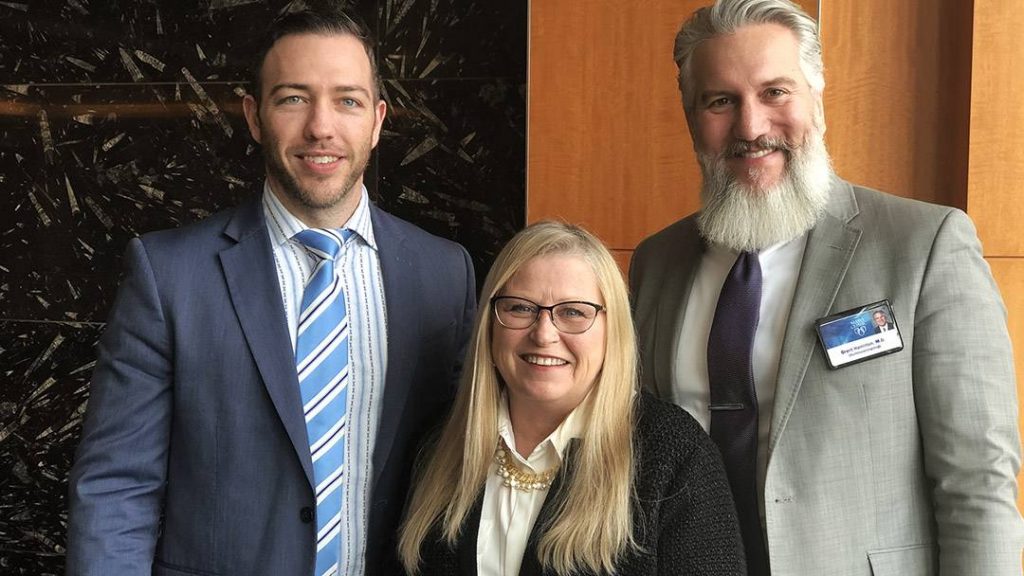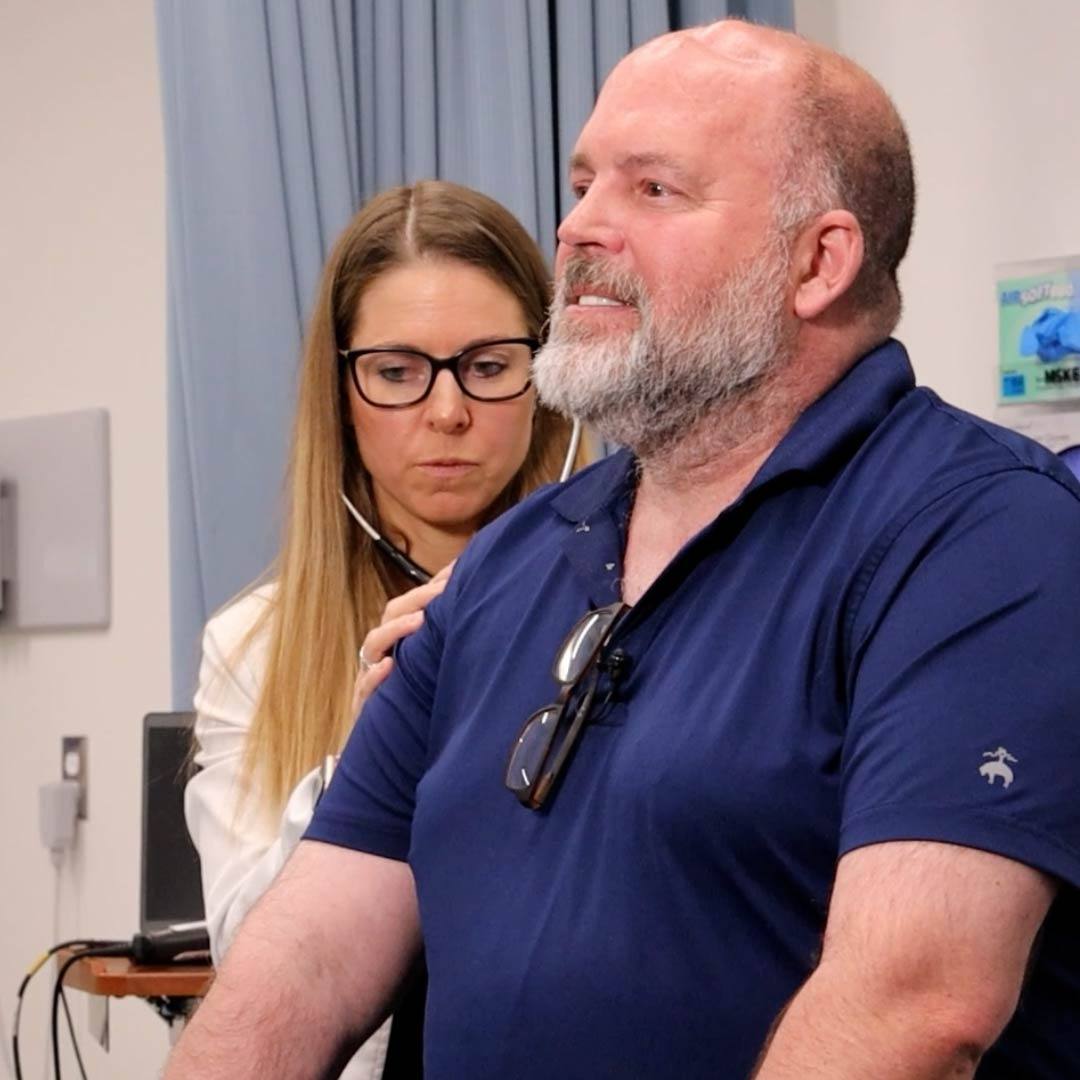
For years, Linda Feges has relied on a multidisciplinary care team at Mayo Clinic to help her address symptoms related to movement disorders. Recently, that team also opened the door for Linda to receive treatment for an odd lump on her face. Now, the lump is gone, and Linda is grateful for the comprehensive, compassionate care she's received.
Like many people who reach a certain age, Linda Feges pined for a smooth forehead. It wasn't wrinkles causing Linda's unhappiness with her appearance, however. For years, an obtrusive bump, just above her nose between her eyebrows, jutted from her face.
At first, the lump didn't cause any problems. But eventually, it began to grow. The pressure of the mass against her sinuses caused her head and face to ache. Linda, a former resident of northern Minnesota who now lives in Arizona, sought medical attention for the lump. But she struggled to find someone locally who could explain what it was. "I couldn't get anyone to look at it," she says.
Last fall, however, while Linda was at Mayo Clinic receiving therapy for a movement disorder, one of her doctors took note. During an appointment in the Department of Physical Medicine and Rehabilitation, Margaret Moutvic, M.D., agreed with Linda that the lump was worth investigating, and she ordered a CT scan of Linda's face.
The scan revealed that Linda's facial lump was an intraosseous hemangioma — a type of growth that develops from blood vessels — that had grown into her skull. In November 2018, Linda had the growth removed by surgeons Garret Choby, M.D., in Otorhinolaryngology, and Jamie Van Gompel, M.D., in Neurosurgery. Into the space left behind when the quarter-sized mass was removed, Grant Hamilton III, M.D., a Mayo Clinic facial plastic surgeon, grafted a piece of healthy skull bone.
"You can't tell I had the surgery," Linda says. "In fact, I look a little bit better than before."
Dealing with more than one malady
Linda's appearance isn't the only part of her life that's improved thanks to her care at Mayo Clinic. She also has received treatment for two movement disorders.
Linda first came to Mayo Clinic's Rochester campus in 2002 suffering from unexplained tremors. At that time, she met with physicians in the Department of Neurology and was diagnosed with myoclonus, a condition marked by involuntary muscle spasms that can vary in length, intensity and location.
Thirteen years later, the tremors got significantly worse and began to affect her mobility. Linda underwent a thorough exam and tests to check for other neurological conditions, such as Parkinson's disease and epilepsy. The results came back negative. Her medical team, which included neurologist James Bower, M.D., concluded that, along with myoclonus, Linda had a type of a functional tremor that caused her legs to shake.
Functional tremors are linked to the brain's processing involved in movement, says Dr. Bower. They can be caused by factors that cause the brain to memorize a maladapted way to perform a certain function.
Dr. Bower explains that when someone learns a new activity, like swimming, the learner's brain memorizes, or becomes programmed to perform, that activity. Once the activity is programmed, it becomes permanently imprinted in the brain.
"You can't put an adult who knows how to swim into a body of water and say, 'Don't swim,'" Dr. Bower says. "How to move in the water is something memorized and ingrained on the brain, and you can't forget it."
In cases of functional disorders, including functional tremors, an alternate way of moving overrides the brain's programming and causes abnormal movements.
Managing a complex condition
Treating functional disorders can involve a number of approaches, including physical and occupational therapy, as well as psychotherapy. Key to Linda's therapy was removing the physical and environmental triggers that led to her leg tremors.
"That's why I moved to Arizona," says Linda, explaining that she and her husband relocated to the Southwest 11 years ago. "Cold is one of my triggers, and I was getting stuck in the parking lots at work because my muscles would just stop in the cold. I'd be stuck there until somebody came and helped me out."
Linda modified her life to minimize symptoms, so she could move and carry on her job as a nurse practitioner. But four years ago, after herniating a disc in her spine, she suffered a serious flare-up of symptoms. The back pain caused her tremors to become almost constant. The unceasing jerking and twitching incapacitated Linda. In pain and unable to work, she returned to Mayo Clinic for help.
"They develop a plan that is specific to you, based on what your tremors are like and what your goals are."
Linda Feges
Linda's team at Mayo directed her to the BeST, or Behavior Shaping Therapy, program. The week-long program included occupational, physical and psychological components. Unlike traditional physical therapy, where the focus is on muscle strengthening, the exercises stressed in the BeST program focus on muscle relaxation, Linda says.
"They give you the tools that you can use to deal with the tremors and kind of retrain your brain, so you move differently and try not to trigger the shaking," Linda says. "It was very intensive, all day, every day for a week. They develop a plan that is specific to you, based on what your tremors are like and what your goals are."
A major goal for Linda was descending stairs, which was difficult with the leg tremors. Through the course of BeST, Linda was given different strategies for better managing stairs and downward slopes, she says.
Connecting the dots
The care Linda's received at Mayo Clinic has affected her life on multiple levels, she says. Not only did her medical team identify and diagnose her conditions, but the treatment had a positive effect on Linda's sense of self and her abilities.
Especially significant to Linda was the compassionate care provided by Dr. Hamilton and the multidisciplinary team that removed the hemangioma on her face. For example, to minimize the effects of surgery on Linda's appearance, Dr. Hamilton made the surgical incisions between braids in her hair that had been plaited prior to the surgery.
"I have long hair, and it was a big deal that someone took the time to come in and braid my hair, so Dr. Hamilton could cut around my braids," Linda says. "They didn't have to shave my head, and I don't know anywhere else where they would do that."
"They were so kind, and they explained things so well."
Linda Feges
What's more, during the surgery while Linda was anesthetized, she experienced multiple episodes of involuntary movement. That allowed her surgical team to help her neurological team confirm the diagnosis of myoclonus. "Everything just came together," Linda says. "Even though they can't treat my myoclonus, just knowing and having a solid diagnosis is everything."
For many patients with movement disorders, naming their condition is an important part of recovery, Dr. Bowers says.
"I think that naming it, explaining it and having some physical therapy and occupational therapy can be tremendously helpful for patients," Dr. Bowers says. "At Mayo, I think we're better at communicating these things in very honest ways and in less judgmental ways."
The treatment Linda's received at Mayo Clinic has been full of care and consideration, she says. "They were so kind, and they explained things so well. They were able to confirm my diagnosis, which is a big deal because it had been difficult to diagnose. It's just another example of how they all work together. You just don't find that anymore. It's amazing."
HELPFUL LINKS
- Learn more about hemangiomas and movement disorders.
- Read about sinus surgery at Mayo Clinic.
- Check out Mayo Clinic's Facial Plastic Surgery.
- Visit the Departments of Neurology and Neurosurgery.
- Connect with others talking about brain and nerve diseases on Mayo Clinic Connect.
- Explore Mayo Clinic.
- Request an appointment.







